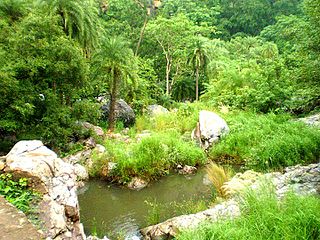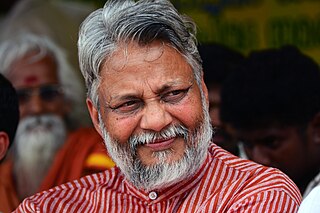
Rajasthan is a state in northern India. It covers 342,239 square kilometres (132,139 sq mi) or 10.4 per cent of India's total geographical area. It is the largest Indian state by area and the seventh largest by population. It is on India's northwestern side, where it comprises most of the wide and inhospitable Thar Desert and shares a border with the Pakistani provinces of Punjab to the northwest and Sindh to the west, along the Sutlej-Indus River valley. It is bordered by five other Indian states: Punjab to the north; Haryana and Uttar Pradesh to the northeast; Madhya Pradesh to the southeast; and Gujarat to the southwest. Its geographical location is 23.3 to 30.12 North latitude and 69.30 to 78.17 East longitude, with the Tropic of Cancer passing through its southernmost tip.

The Aravalli Range is a mountain range in Northern-Western India, running approximately 670 km (430 mi) in a south-west direction, starting near Delhi, passing through southern Haryana, Rajasthan, and ending in Ahmedabad Gujarat. The highest peak is Guru Shikhar on Mount Abu at 1,722 metres (5,650 ft). The Aravalli Range is arguably the oldest geological feature on Earth, having its origin in the Proterozoic era.

Sariska Tiger Reserve is a tiger reserve in Alwar district, Rajasthan, India. It stretches over an area of 881 km2 (340 sq mi) comprising scrub-thorn arid forests, dry deciduous forests, grasslands, and rocky hills. This area was a hunting preserve of the Alwar state and was declared a wildlife sanctuary in 1958. It was given the status of a tiger reserve making it a part of India's Project Tiger in 1978. The wildlife sanctuary was declared a national park in 1982, with a total area of about 273.8 km2 (105.7 sq mi). It is the first reserve in the world with successfully relocated tigers. It is an important biodiversity area in the Northern Aravalli leopard and wildlife corridor.
The Gambhir River, which is also known as the Utangan River, is an ephemeral (seasonal) river in India which originates in Rajasthan state and confluences with Yamuna in Uttar Pradesh state. Important tributaries of the Gambhir are Banganga, Sesa, Kher and Parbati.
Gurgaon district, officially known as Gurugram district, is one of the 22 districts of Haryana in northern India. The city of Gurgaon is the administrative headquarters of the district. The population is 1,514,432. It is one of the southern districts of Haryana. On its north, it is bounded by the district of Jhajjar and the Union Territory of Delhi. Faridabad district lies to its east. On its south, lie the districts of Palwal and Nuh. To its west lies Rewari district.

Jal Mahal is a palace in the middle of the Man Sagar Lake in Jaipur city, the capital of the state of Rajasthan, India. The palace was originally constructed in 1699; the building and the lake around it were later renovated and enlarged in the 18th century by Maharaja Jai Singh II of Amber.

Rajendra Singh is an Indian water conservationist and environmentalist from Alwar district, Rajasthan in India. Also known as "waterman of India", he won the Magsaysay Award in 2001 and Stockholm Water Prize in 2015. He runs an NGO called 'Tarun Bharat Sangh' (TBS), which was founded in 1975. The NGO based in village hori-Bhikampura in Thanagazi tehsil, near Sariska Tiger Reserve, has been instrumental in fighting the slow bureaucracy, mining lobby and has helped villagers take charge of water management in their semi-arid area as it lies close to Thar Desert, through the use of johad, rainwater storage tanks, check dams and other time-tested as well as path-breaking techniques. Starting from a single village in 1985, over the years TBS helped build over 8,600 johads and other water conservation structures to collect rainwater for the dry seasons, has brought water back to over 1,000 villages and revived five rivers in Rajasthan, Arvari, Ruparel, Sarsa, Bhagani and Jahajwali. He is one of the members of the National Ganga River Basin Authority (NGRBA) which was set up in 2009, by the Government of India as an empowered planning, financing, monitoring and coordinating authority for the Ganges (Ganga), in exercise of the powers conferred under the Environment (Protection) Act, 1986. In the UK he is a founder member of an NGO called the Flow Partnership. which aims to counter the negative effects of soil erosion and flooding.

An irrigation tank or tank is an artificial reservoir of any size. They are mainly found in India. It can also have a natural or man-made spring included as part of a structure. Tanks are part of an ancient tradition of harvesting and preserving the local rainfall and water from streams and rivers for later use, primarily for agriculture and drinking water, but also for sacred bathing and ritual. Often a tank was constructed across a slope so to collect and store water by taking advantage of local mounds and depressions. Tank irrigation is practised by constructing mud banks across small streams to make a small reservoir which collect excess water during the rainy season.Tank use is especially critical in parts of South India without perennial rainfall where water supply replenishment is dependent on a cycle of dry seasons alternating with monsoon seasons.

Delhi Ridge, sometimes simply called The Ridge, is a ridge in the Northern Aravalli leopard wildlife corridor in the National Capital Territory of Delhi in India. It is a northern extension of the ancient Aravalli Range, some 1.5 billion years old. The ridge consists of quartzite rocks and extends from the southeast at Tughlaqabad, near the Bhatti mines, branching out in places and tapering off in the north near Wazirabad on the west bank of the river Yamuna, covering about 35 kilometres.

A johad, also known as a pokhar or a percolation pond, is a community-owned traditional harvested rainwater storage wetland principally used for effectively harnessing water resources in the states of Haryana, Rajasthan, Punjab, and western Uttar Pradesh of North India, that collects and stores water throughout the year, to be used for the purpose of recharging the groundwater in the nearby water wells, waby humans and cattle]]. Some johads also have bricked or stones masonry and cemented ghat.
The Arvari River, which originates in Aravalli range, is a small river flowing through the Alwar District of Rajasthan, India. It has a total length of 45 km (28 mi) and a total basin area of 492 squared kilometers. Downstream of the Sainthal Sagar dam on Arvari, the Arvari river meets Sarsa River to become the Sanwan River. The Sanwan meets the Tildah and Banganga rivers to confluence with the Gambhir. Gambhir then confluences with the Yamuna in Mainpuri district of Uttar Pradesh, Yamuna confluences with Ganges at Triveni Sangam in Prayagraj. The Arvari is the main water source for the Alwar district.

Rajasthan is one of the most popular tourist destinations in India, for both domestic and international tourists. Rajasthan attracts tourists for its historical forts, palaces, art and culture with its slogan "Padharo mhare desh', now its changed. Every third foreign tourist visiting India travels to Rajasthan as it is part of the Golden Triangle for tourists visiting India.

A taanka, also known as a tanka or kund, is a traditional rainwater harvesting technique, common to the Thar desert region of Rajasthan, India. It is meant to provide drinking water and water security for a family or a small group of families. A taanka is composed of a covered, underground, impermeable cistern on shallow ground for the collection of rainwater. The cistern is generally constructed out of stone or brick masonry, or concrete, with lime mortar or cement plaster. Rainwater or surface run-off from rooftops, courtyards, or artificially prepared catchments flow into the tank through filtered inlets in the wall of the pit.

Asola-Bhati Wildlife Sanctuary covering 32.71 km2 area on the Southern Delhi Ridge of Aravalli hill range on Delhi-Haryana border lies in Southern Delhi as well as northern parts of Faridabad and Gurugram districts of Haryana state. Biodiversity significance of Ridge lies in its merger with Indo-Gangetic plains, as it is the part of the Northern Aravalli leopard wildlife corridor, an important wildlife corridor which starts from the Sariska National Park in Rajasthan, passes through Nuh, Faridabad and Gurugram districts of Haryana and ends at Delhi Ridge.
National Alliance of People's Movements is an alliance of progressive people's organizations and movements in India. It is an umbrella organisation for a larger alliance integrating various civil society organisations and individuals working towards similar goals.
Mama Baleshwar Dayal was a social worker and socialist politician from India. He is remembered for his work among the Bhil tribes of Rajasthan and Madhya Pradesh whom he organised to fight for their rights to jal, jungle aur jameen.
Forests Department, Haryana is a department of the Government of Haryana in India that runs and maintains many protected nature areas in the state of Haryana. It has two administrative divisions: Forest and Wildlife. The department is responsible for maintaining National Parks, Wildlife Sanctuaries and Conservation Reserves in Haryana. It also provides a special emphasis on Soil and Moisture Conservation works in the hills to conserve water and deliver it to adjacent farmlands. Two National Parks, eight Wildlife Sanctuaries, two Conservation Reserves, four Animal & Bird Breeding Centres, one Deer park, and 49 herbal parks. Kanwar Pal Gujjar has been the cabinet minister responsible for this department since October 2019. constitute the Protected Area network of the department, covering 0.75% of the state. It also maintains a list of Protected Areas in Haryana.
Banganga River, an 240 km long tributary of Gambhir river in India, originates from the hills of Aransar and Bairath in Jaipur region of Rajasthan state and confluences with Yamuna near Fatehabad in Agra district of Uttar Pradesh state. Its main tributaries are Gumti Nalla and Suri River on right bank, and Sanwan and Palasan Rivers on left bank. Banganga's tributary Sanwan after confluencing with Tildah river then confluences with Banganga river which in turn then confluences with the Gambhir river which in turn confluences with the Yamuna in Mainpuri district of Uttar Pradesh. Finally, Yamuna confluences with Ganges at Triveni Sangam in Prayagraj.

Masani barrage, also Masani bridge, a barrage on the seasonal Sahibi River completed in 1989, is named after the Masani village in Rewari District of Haryana in India. Masani barrage also serves as a bridge on NH 919. Water storage in the barrage was made perennial in 2017 after a gap of 50 years. This barrage is important part of ecological corridor along the route of Sahibi river which traverses from Aravalli hills in Rajasthan to Yamuna via Matanhail forest, Chhuchhakwas-Godhari, Khaparwas Wildlife Sanctuary, Bhindawas Wildlife Sanctuary, Outfall Drain Number 8 and 6, Sarbashirpur, Sultanpur National Park, Basai and The Lost Lake (Gurugram).
Jahajwali river is one of the smallest rivers in the Aravalli hills of Rajasthan. It originates in Devari, Guwada in Rajgadh Tahsil of Alwar district in Rajesthan state, India. It covers total geographic area of 89 km2.












